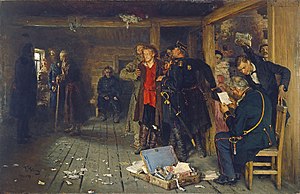Okhrana
The Ojrana or Ojranka (pejorative) (from Russian Охранное отделение, Ojránnoyie otdeléniye, Security Department) was the secret police force of the tsarist regime in the Russian Empire founded in 1866, after the first assassination attempt on Alexander II.
Organization and methods
The Okhrana was part of the Ministry of the Interior (MVD), aided by the Special Corps of Gendarmes. Its main objective was to guarantee the safety of the imperial family; Given the conditions in the country at the time, this meant that a good part of their actions were focused on the repression of revolutionary activities, especially by the anarchist and socialist groups that planned to end the Romanov dynasty.
Since a good part of the revolutionary organizations had headquarters outside of Russia, the Okhrana had numerous agents throughout Europe, especially in Paris, where Pyotr Rachkovsky was stationed (1884-1902). Many of these operated by infiltrating the revolutionary groups as moles or agents provocateurs, thus keeping the central office informed of the activity plans and inciting the combatants to carry out unsuccessful actions. desperate or unpopular. Among the most prominent agents are Dr. Yakov Zhitomirski, who became a close associate of Lenin, Yevno Azef, Dmitri Bogrov, Father Gapon, who led the peaceful mobilization of workers massacred by the Imperial Guard on Bloody Sunday 1905 and since 1956 there has been speculation about Stalin, accused by the spy Orlov. The Okhrana also tried to subdue the labor movement by creating unions controlled by the police, a practice known as zubatovschina.
Normal Okhrana procedure included turning prisoners over to the judiciary for trial according to law, with their subsequent execution or shipment to labor camps in the far northeast of Siberia known as katorgas. However, under special circumstances, the officers were licensed to carry out summary executions and torture.
The Okhrana also recruited large numbers of women to serve as agents inside and outside Russia. The effectiveness of these agents resided in their ability to approach the leaders of terrorist groups and to lead different parallel lives with great discretion and skill. Anna Gregoriyeva Serebryakova was one of the most successful agents and her career included monitoring various revolutionary groups as well as maintaining a stable communication channel between different anarchist leaders.
One of the most complete sources, as well as close in time, would be "What every revolutionary should know about repression", written by the Trotskyist Victor Serge in 1925. This historical and historiographical document was written in the early years of the Soviet Union, when the organization of the state was led by those who had been the most political targets of the Okhrana.
There is also an interesting book published in Spain by Espasa Calpe in 1941 about this police force. It is titled "Ochrana" and it is the translation of the memoirs of Alekséi T. Vasíliev (written on the cover, in the German manner, as "Wassiliew"), the last active director of tsarist security. In it, Vasiliev justifies himself by trying to present the police actions of the Okhrana from the point of view most favorable to his image, aware that the Russian people's view of his activities was very unfavorable.
Fonts
- Charles A. Ruud, Sergei A. Stepanov; Fontanka 16 - The Tsars' Secret PoliceMcGill-Queen's University Press (paperback, 2002) ISBN 0-7735-2484-3
- Political Police and State Terrorism in Russia (second half of the nineteenth century, early twentieth century). Collection of documents compiled by V.I. Kochanov, N.N. Parfyonova, M.V. Sidorova, Ye. I. Sherbakova. Moscow, AIRO-XX (2000). ISBN 5-88735-079-2. (In Russian). [1]
- La Ojrana in Paris, 1885-1905 Archived on 18 November 2005 at Wayback Machine. (English)
